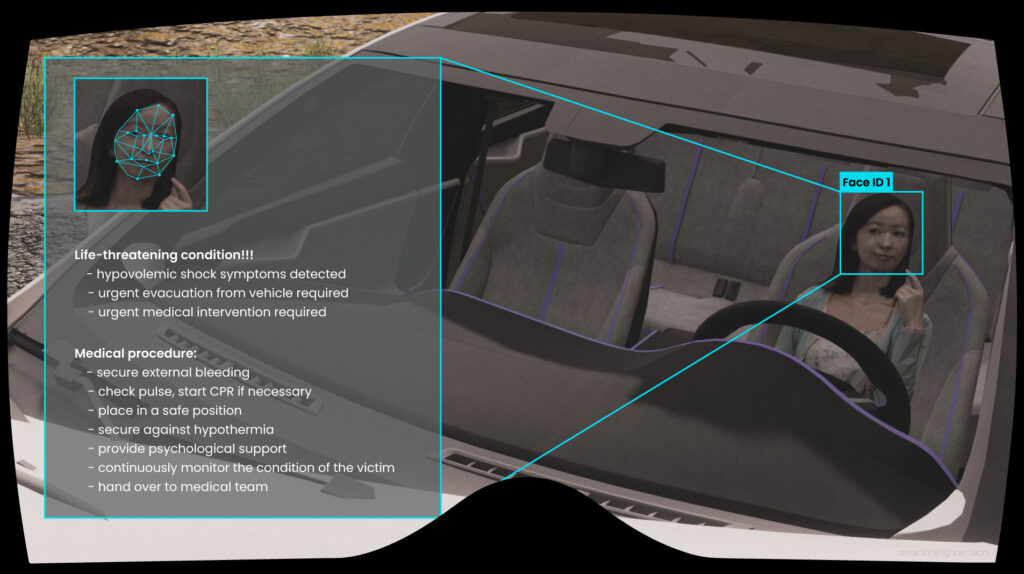technology in the service of humanity

Can AI powered Medical Assistant revolutionize emergency scenes?
Facial recognition technology has been developing for decades, but the intersection of facial analysis and disease diagnosis is still an emerging field.
Facial analysis provides information in regards to age, sex, race, consciousness, emotion, and what is important for rescuers – health status. Usually diseases and health status not only manifests as internal structural and functional abnormalities, but also have facial characteristics and appearance deformities and specific body kinematics. Victim emotion, face and body expression together are essential dimensions in future medical facial recognition technology.
In recent years, facial recognition has been applied in acute illnesses for faster screening and patient triage in some emergency room.
The same technology can serve rescuers and first responders in emergency scene. As more mature products from researchers are forthcoming, therefore there is no reason why this cutting-edge technology could not be incorporated into the smartfirefighter systems of the future. For the front line rescuers and firefighters the system does not have to provide precise diagnosis. It is enough only if it facilitates the correct assessment of the condition of the victim (something like fast and accurate triage). It will be enough to definitely improve rescuer’s performance and help them with the professional and rapid diagnosis of the accident victim.
Of course the AI powered Medical Assistant is not intend at all to tell a responders what to do. Rescuers always will be the decision-making and always in full control. AI powered device that assists responders while they are delivering medical care at the scene could just reduce stress and cognitive overload and improve outcomes for both the victims and responders.
In general, the firefighter’s medical knowledge level needed in a particular situation may be a challenge, especially for rescuers who do not have sufficient experience. Therefore, the effectiveness of facial recognition technology has hypothetically is able to give rise to the opportunity for a more time-saving diagnosis with less interference coming from rescuer’s error.
In the smartfirefighter system being currently designed and developed the whole process may work in a clearly defined way.
After facial and body images of acceptable quality are obtained form the firefighter’s cameras, these images can be processed in a defined steps: face and body pose detection, feature extraction and health state classification.
In consecutive steps the collected images are first preprocessed and normalized then face and body position are detected, described and matched witch corresponding features from the database. When the similarity exceeds a certain threshold, the image is classified and diagnose defined.
Just so it’s not quite that simple there are many factors affecting the accuracy of facial recognition and body pose estimation. Including things like defects originated from the environment, lightning and camera conditions, user’s face conditions, and user-camera positioning.
The good news, on the other hand, is that these elements are continuously being optimized to reduce the impact of all of above factors for the final result.
There is more one issue that also needs to be taken into account with this type of medical system for smartfirefighter.
Currently, the human face is a sensitive individual privacy concern. Ethical implications of facial recognition technology require more regulations and laws when using this novel technique in victim’s disease diagnosis. Security, privacy, autonomy, and democratic accountability are the most considered aspects. In described solution, facial images of patients should be taken seriously as the medical record.
To mention similar, real world example (developed by University of Virginia researchers) which is tested now – first responders in Virginia are testing an AI assistant developed by researchers that is designed to aid decision-making at emergency scenes.
The tool uses artificial intelligence that listens to first responders’ conversations at the scene and provides prompts meant to improve responders’ situational awareness and support decision-making. The system listens for information such as vitals, symptoms and other facts involved in the incident, then analyzes the information to provide the most helpful prompt for the situation.
So, it looks like the AI powered Medical Assistant is closer to the firefighters and emergency responders as we think.